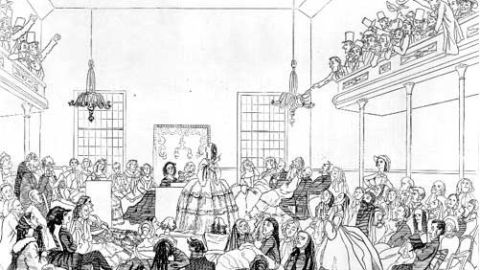Seneca Falls 165 Years Later, Women’s Rights, and the Quality of an Idea

This week in 1848, 68 women and 32 men signed a Declaration of Rights and Sentiments for women’s equality. This document, and the convention at Seneca Falls, New York, out of which it took form, inaugurated the modern women’s rights movement.
The 100 participants out of 300 in attendance who signed the document already had a template in mind, and from which the document borrows heavily: the Declaration of Independence.
In homage to Seneca Falls I’ve been thinking about how we judge the quality of an idea as an historical entity (I’m distinguishing idea from religious faith).
This sort of question preoccupied the founder of intellectual history, Johns Hopkins professor Arthur Lovejoy, who died in 1962. He lived not too far from my neighborhood, a lifelong bachelor whose apartment was so cluttered with books that he had nowhere to sleep. Lovejoy was on an all-consuming quest after the archaeology of ideas, and devised a concept of a “unit idea.” To simplify vastly, unit ideas are like the smallest components of an atom. They’re elemental, persistent concepts and ideas that recur throughout history and culture, and whose meanings adapt and change subtly through use.
I think we can judge the quality of an idea by its desirability and its capaciousness: How much do people want to belong to it, and how much does the idea expand to accommodate them. How much can it encompass subjects not originally included; in fact, expressly excluded in its initial articulation?
In assessing the quality of an idea, consideration of the people who are ultimately included might be more (or equally) important as recognition of those who were originally excluded.
A crucial body of scholarship elaborates the ways that U.S. history is based on consequential exclusions of various kinds, but its core idea has grown to include, as well.
In 1848, women found their way in to the idea of democratic quality embodied in the Declaration of Independence because of the desirability and the capaciousness of the idea. They read a document about all men being equal in a society where they had no right of franchise, and extremely limited property rights or personal protections and freedoms and, were able to read into the document, the subject of women. It’s that ability to read into the idea that makes it so compelling and persistent.
Some ideas no one wants to join. Or, maybe they want to join, but can’t, lest the idea itself implode. Racial supremacy and bigotry are like that. They’re an “idea” based on an inviolable exclusion, and hierarchy: The very soul of the loathsome idea is to exclude, or subordinate.
Without that exclusion, the idea has nothing, is nothing. And, even if the excluded group in the first elaboration of supremacy establishes a reverse, cryptographic theory of its own to assert their supremacy instead, the same exclusionary logic applies, to someone, somewhere. Bigotry and supremacy still flare historically, but it’s a rotten idea as an idea, owing to its stagnation, and immutability.
The capacity of the idea to include and expand is a replenishing force. As new groups seek to belong to the idea, advocate for inclusion, and then achieve it, they teach or remind the already-included of the idea’s soul, or essence, and the idea is rejuvenated, and refined.
During the Civil Rights movement, African Americans who had been most brutally denied the fruits of the Declaration of Independence were its strongest advocates and believers, and taught the rest of us the most about the idea.
So, while I’m sympathetic to poststructuralist and post-modern relativism, and its critiques of how the Enlightenment discourses of individualism, individual rights, and equality play out their own insidiously subtle forms of power and exclusion, I still have to say, as an historical artifact rather than a philosophical one, the Declaration of Independence has had some extremely impressive appeal, and capaciousness, and kicks some serious ass. As my 11-year old would say, it’s The Boss.




